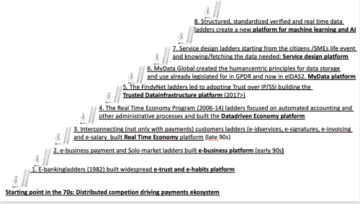
Banks are accelerating green lending and investing initiatives as they march towards realizing their net zero goals, partnering with their counterparties to reduce the combined carbon footprint. As I said in my last blog post[1],
here are a few thoughts on “all that is green is not gold” and why robust risk management aspects and constructs merit serious consideration for green funding initiatives, much the same or perhaps a little more, given that these are relatively new.
All projects/ proposals that come with a “green” label are not necessarily “gold” or fund worthy. As banks speed track to green their businesses and balance sheets, it is imperative to keep in perspective that not all “green” options are low risk/ no risk
options. This is especially so given that the associated approaches, policies, technologies, and client experiences with them are evolving, with some still in their infancy.
Beginning at the beginning
It is a given that banks hold sizeable financial resources, and that the fund requirement for moving towards low carbon economy is huge, with estimates ranging from high billions to lower trillions of Dollars. To capture and play in this huge market, banks
are launching innovative products like “Green Mortgages”, “Green Loans”, “Green Credit Cards”, “Green Car Loans”, etc. on the retail side in addition to green projects like development of renewable energy, green buildings, wastewater management etc. on the
corporate side.
Well-designed sustainability programs have the power to shape the narrative of lowering the carbon footprint, while ensuring sustainable growth for the banks and their customers, provided the risk angle is also effectively addressed.
Fundamental to lending or investing is the clear expectation that the funds will be returned on agreed terms and/or meet the agreed objectives. This essentially means that the projects are to be
“VIABLE”. Sound risk assessment of viability across time is a must. This is what risk processes are expected to manage and monitor. Embedding sustainability aspects into credit risk assessment or investment assessment is central to prudent decision
making. Credit/ investment worthiness of the project and its promoters, set in the context of sustainability, continue to be core to lending/ investment process even while considering green options.
While all three climate risk drivers, viz. Physical risks, Transition risks and Liability/ Legal risks are to be watched out for and factored in, the more challenging of these, from a risk assessment perspective, are the Transition risks which can increase
the credit risks, since the paths that the transition arcs may take are hazy. Banks with large portfolios of high emitting industries and SMEs face higher transition risks and thereby increased probability of credit defaults and losses. This is so because
these industries and customers are affected by cost of pollution, changes in ESG regulations, flux in evolving technologies. This is where the “viability” assessment, especially over the medium to long term becomes challenging. “What complicates the canvas
is that Climate change risks are multilayered, multithreaded and intertwined.”[2]
I have browsed though second party opinions (SPO)[3] of a few financial institutions that have established a structured sustainability programs which shed some light on the
possible foundational constructs that have enabled these banks’ to be on track to achieve their sustainable lending/ investment goals. One bank[4] has
- “An ESG working group with representation from risk management, ESG, treasury, credit and credit administration” – bringing to fore the wisdom of approaching the intertwined, interconnected subject collectively.
- “An ESG risk management policy to assess the environmental and social impact of loans, categorize risks and implement risk mitigation and management strategies” – A framework that looks at the risk universe in totality.
- “Sustainable Finance framework with eligible “green” categories”. A clear definition of the areas/ projects that qualify as “green” sectors.
Once the strategy and structures are in place, the methodologies and frameworks for assessing sustainability melded project viability criteria are to be framed and followed. This is in the interest of all, including the larger ecosystem. Creating and honing
the skill to identify, assess, measure and manage climate related financial risks effectively and not get diverted by a “green” label alone will stand all stakeholders in good stead. Subjecting green funding decisions to time tested risk management rigor,
will protect not only the businesses of clients but also banks’ own books, while help march towards a cleaner environment.
Having briefly touched the risk angle, in the next blog, will look to exploring the “Sustainable Revenue” angle.
*****************
Notes
[1] COP commitments Climate Finance and Climate Risk – a connected continuum
https://www.finextra.com/blogposting/25564/cop-commitments-climate-finance-and-climate-risk–a-connected-continuum
[2] Climate Change Risk Management in Banks – the Next Paradigm. Saloni Ramakrishna
[3] SPO is an independent point -in-time analysis of a sustainable finance instrument program, or framework.
[4]
https://www.hdfcbank.com/content/bbp/repositories/723fb80a-2dde-42a3-9793-7ae1be57c87f/?path=/Footer/About%20Us/Corporate%20Governance/Codes%20and%20Policie/pdf/SPO_Sustainable_Finance_Framework.pdf
- SEO Powered Content & PR Distribution. Get Amplified Today.
- PlatoData.Network Vertical Generative Ai. Empower Yourself. Access Here.
- PlatoAiStream. Web3 Intelligence. Knowledge Amplified. Access Here.
- PlatoESG. Carbon, CleanTech, Energy, Environment, Solar, Waste Management. Access Here.
- PlatoHealth. Biotech and Clinical Trials Intelligence. Access Here.
- Source: https://www.finextra.com/blogposting/26154/bankers-beware—all-that-is-green-is-not-gold—a-view-through-the-risk-management-lens?utm_medium=rssfinextra&utm_source=finextrablogs
- :is
- :not
- :where
- 1
- 2%
- 4
- a
- accelerating
- Achieve
- across
- addition
- addressed
- affected
- agreed
- All
- alone
- also
- an
- analysis
- and
- angle
- approaches
- approaching
- ARE
- AS
- aspects
- assess
- Assessing
- assessment
- associated
- At
- Balance
- balance sheets
- bankers
- Banks
- BE
- because
- becomes
- Beware
- billions
- Blog
- Books
- briefly
- Bringing
- buildings
- businesses
- but
- by
- CAN
- canvas
- capture
- car
- carbon
- carbon footprint
- categorize
- central
- challenging
- change
- Changes
- cleaner
- clear
- client
- clients
- Climate
- Climate change
- collectively
- combined
- come
- commitments
- connected
- consideration
- considering
- constructs
- context
- continue
- Continuum
- Core
- Corporate
- Cost
- counterparties
- Creating
- credit
- criteria
- Customers
- decision
- decisions
- defaults
- definition
- Development
- dollars
- drivers
- economy
- ecosystem
- effectively
- eligible
- embedding
- enabled
- energy
- ensuring
- Environment
- environmental
- ESG
- especially
- essentially
- established
- estimates
- etc
- Even
- evolving
- expectation
- expected
- Experiences
- Exploring
- Face
- factored
- few
- File
- finance
- financial
- Financial institutions
- Finextra
- FLUX
- followed
- Footprint
- For
- fore
- foundational
- Framework
- frameworks
- from
- fund
- funding
- funds
- get
- given
- Goals
- Gold
- good
- Green
- Group
- Growth
- Have
- Hazy
- help
- here
- High
- higher
- hold
- HTTPS
- huge
- i
- identify
- Impact
- imperative
- implement
- in
- Including
- Increase
- increased
- independent
- industries
- initiatives
- innovative
- institutions
- instrument
- interconnected
- interest
- intertwined
- into
- investing
- investment
- investment goals
- IT
- ITS
- jpg
- Keep
- Label
- large
- larger
- Last
- launching
- Legal
- lending
- Lens
- light
- like
- little
- Loans
- Long
- Look
- LOOKS
- losses
- Low
- lower
- lowering
- Making
- manage
- management
- March
- Market
- May..
- means
- measure
- medium
- Meet
- Merit
- methodologies
- mitigation
- Monitor
- more
- moving
- much
- MultiLayered
- must
- my
- NARRATIVE
- necessarily
- net
- New
- next
- no
- of
- on
- ONE
- only
- Opinions
- Options
- or
- out
- over
- own
- paradigm
- partnering
- party
- paths
- perhaps
- perspective
- physical
- Place
- plato
- Plato Data Intelligence
- PlatoData
- Play
- Point
- policies
- policy
- Pollution
- portfolios
- possible
- power
- probability
- process
- processes
- Products
- Program
- Programs
- project
- projects
- promoters
- Proposals
- protect
- provided
- prudent
- qualify
- ranging
- realizing
- reduce
- regulations
- related
- relatively
- Renewable
- renewable energy
- representation
- requirement
- Resources
- retail
- revenue
- Risk
- risk assessment
- risk management
- Risk Mitigation
- risks
- robust
- Said
- same
- Second
- Sectors
- serious
- set
- Shape
- shed
- sheets
- side
- since
- skill
- SMEs
- So
- Social
- Social impact
- some
- Sound
- speed
- stakeholders
- stand
- Still
- Strategy
- structured
- structures
- subject
- Sustainability
- sustainable
- Sustainable Growth
- Take
- Technologies
- term
- terms
- tested
- that
- The
- The Projects
- their
- Them
- thereby
- These
- they
- this
- though?
- three
- Through
- time
- to
- Totality
- touched
- towards
- track
- transition
- treasury
- trillions
- Universe
- viability
- View
- What
- which
- while
- why
- will
- wisdom
- with
- working
- Working Group
- worthy
- zephyrnet
- zero












